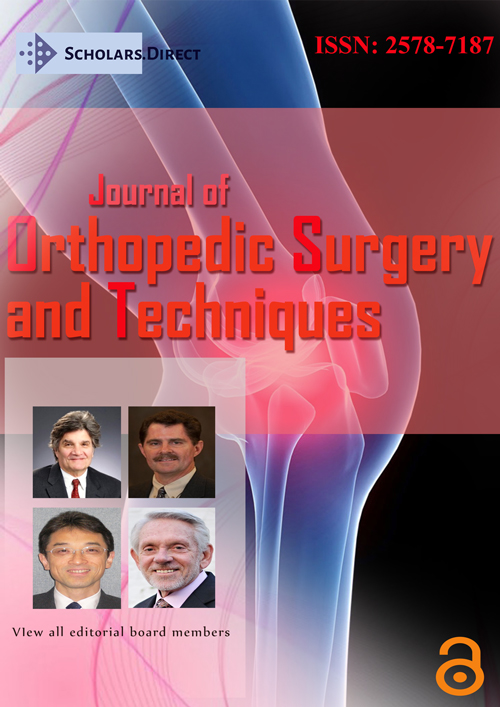Predictive Factors for Length of Hospital Stay after Primary Total Hip Replacement in an Asian Joint Replacement Center
Abstract
Introduction: The continuously expanding aging population in Hong Kong is expected to have a tremendous increase in demand for joint replacement service in the coming 20 years. There are various existing overseas studies on prediction of length of stay (LOS) after total hip replacement (THR) on western demographics. However, the length of stay and cultural background of Caucasian population are significantly different from local data. There is a knowledge gap for a local study to determine the factors of the Hong Kong population. Also, shortening hospital stay helps minimize the associated medical cost. Hence, the objective of this study is to identify various predictors for length of hospital stay following primary total hip replacement performed at a joint center in Hong Kong.
Method: All primary total hip replacements performed from 1/1/2018 to 30/6/2023 at Tseung Kwan O Hospital Joint Replacement Center were retrospectively reviewed. A number of postulated factors, ranging from patient, surgical to post-operative variables which were suggested to lengthen the hospital stay, were collected and analyzed.
Result: A total of 100 patients, out of 106 retrieved, were included in this study. The mean length of hospital stay was 15.4 days, which was distinctive from figures in overseas studies. Predictors of prolonged hospital stay included advanced age, post-operative intensive care unit care and a pre-operative low Risk Assessment Prediction Tool (RAPT) score.
Conclusion: By defining the associated factors of prolonged hospital stay, physicians should be able to improve the current practice in joint replacement surgery. Stratifying the high-risk group of patients pre-operatively empowers clinicians for better anticipation and customizing discharge arrangement.
Keywords
Total hip replacement, Factors, Length of hospitalization
Introduction
Hong Kong is facing the problem of aging population [1]. More demand for replacement operation is expected. There were multiple overseas studies focusing on preoperative and perioperative predictors of prolonged length of hospital stay (LOS) after primary total hip arthroplasty (THR) [2,3]. It was believed that shortening length of hospital stay led to a reduction in medical cost. Moreover, patients receiving total hip replacement generally stayed longer compared to their counterparts undergoing total knee replacement. Unlike in the United States and United Kingdom where THR is performed in a day-surgery manner, post-op in-patients care is still the mainstream in Hong Kong and Asia. However, no similar local data have been collected and studies published. In view of the significant difference in length of stay, patient demographics and cultural background between overseas and local hospitals, there is a need for this retrospective investigation to explore the perpetuating factors for discharge following primary THR in Hong Kong.
Methods
Study design
A retrospective evaluation of the electronic medical records at Tseung Kwan O Hospital was carried out. The primary outcome of this study was the length of hospital stay. It was defined as the total number of days staying in hospital, including both the days of admission and the day of discharge. All hospital days, including intensive care unit (ICU) period, rehabilitation ward duration and time of transferal to other specialties, were counted.
Population
All primary total hip replacements performed at Tseung Kwan O Hospital Joint Centre from 1/1/2018 to 30/6/2023 were included in this study. Both primary and secondary osteoarthritis cases were part of this review. No age limitation was set in selecting cases. Exclusion criteria included revision total hip replacement, non-elective hip replacement surgery, hip fracture cases, one-stage bilateral procedures and in-patient mortality. A standardized clinical protocol, comprising pre-operative and post-operative investigations, monitoring and mobilization was applied to all eligible patients.
Pre-operatively, all patients attended a pre-admission consultation 1 to 2 months before the operation. Multi-disciplinary approach was adopted. A specialized nurse, physiotherapist, occupational therapist and dietitian teamed up for the pre-habilitation phase. Procedure, indications, rehabilitation goals and complications of replacement surgery were explained. Meanwhile, patients were assessed by anesthetist 1 month before the operation for preoperative work-up and fitness assessment.
Patients were admitted to the designated ward in the morning of the operative day at 07:30. According to the protocol, they would all receive 1-gram intravenous cefazolin on induction (or intravenous vancomycin infusion if allergy existed) and intra-articular trans-amine injection intra-operatively. All hip replacement surgeries were performed or supervised by an experienced joint surgeon. In the center, all operations were completed with posterior approach and cementless implants (both acetabulum and femur sides).
Post-operatively, 3 days of intravenous cefazolin (or vancomycin if contraindicated) were used. Abduction pillow was utilized for 3 days after the operation. On post-op day 0, patients were instructed to resume oral diet. On the next day, routine blood tests for complete blood count, liver and renal functions were performed. Patients were allowed to sit out in a high-low chair. Bedside activities of daily living training began after removal of surgical drain, if the daily output was less than 100 ml. Transfusion of pack cell was provided if hemoglobin level was lower than 8 g/dL. On post-op day 2, bed mobility function training and limb maintenance mobilization exercise started. On day 3 and onwards, further training like toilet training was initiated.
Patient was allowed to discharge only if all discharge criteria were met. Discharge criteria included a satisfactory wound condition, pain score less than 6 over 10, modified functional ambulatory category (MFAC) within 5 to 7 and a capability for basic activity of daily living.
All patients would have follow-up consultation with X-ray performed in our joint out-patient clinic in 6 to 8 weeks after discharge. At the same time, a corresponding specialized nurse would have close communication and follow-up with patients after discharge.
Data extraction
Data was collected retrospectively from Hospital Authority’s Clinical Management System. After reviewing all available data in the medical records, consensus was reached by both investigators upon selection of patients enrolled in this study and the type of data included in the analysis. Demographics, including age [2,3], gender [4], American Society of Anesthesiologists (ASA) grade [2,3] and body mass index (BMI) were included. As suggested by existing literature, patient’s records were screened for presence of various co-morbidities, like deranged renal function [2], psychiatry illness [4], obesity [5], diabetes mellitus [2] and chronic obstructive pulmonary disease [2].
Pre-operative and post-operative blood test results, including whole blood count, inflammatory markers, fasting glucose, albumin, liver and renal function [6], were also collected. Surgical details and anesthetic methods were retrieved from operative and anesthetist records, including operative time [2,3], intra-operative blood loss [2] and whether robotic-assistance was used. Post-operative factors, like requirement of blood transfusion [2], urinary catheterization [7] and intensive care unit support [2] were analyzed.
Pre-operative functional scores, like Modified Functional Ambulation Category (MFAC), Modified Barthel Index (MBI), Montreal Cognitive Assessment (MoCA) and Risk Assessment and Prediction Tool (RAPT) were retrieved from physiotherapists’ and occupation therapists’ assessment records.
Data processing
As the hospital length of stay showed a highly positive skewed distribution, non-parametric approach was adopted. A univariate analysis was performed first. Factors were divided into continuous and categorical variables. On continuous variable, Spearman’s rank correlation was administered to identify the significant factors. On categorical variable, Mann-Whitney test was performed. Afterwards, only the significant predictive factors were further analyzed by stepwise multivariable linear regression to determine the significance of each positive factor after adjusting other factors. A P value of ≤0.05 was considered statistically significant in this study. All analyses were conducted by Statistical Product and Service Solutions (SPSS) software for statistical computing.
Results
Demographic and anthropometric data
There were 106 cases retrieved in the mentioned period. 100 cases were included after review. 59 cases involved female patients and 41 cases were male patients. The mean average length of stay was 15.4 days (range: 5-135 days). The mean age of all patients was 63.2 years-old (range: 22-81 years-old). Figure 1 shows the distribution of hospital stay of all cases included. Figure 2 indicates the distribution of age of patients recruited.
Continuous variable
Calculated from the univariate model, factors significantly associated with increased hospital stay included: Advanced age, high ASA class, increased pre-operative MOCA score and a low RAPT score. Detailed coefficients are reported in Figure 3.
Categorical variable
After all variable were fitted into the univariate model, only two variables were shown to be associated with the hospital length of stay. They were the need of post-op urinary catheterization and the need of ICU admission post-operatively (Figure 4).
Multivariate regression analysis
In order to review the independent significance of each factor shown in the univariate analysis, a stepwise multivariable linear regression process was performed. All the above positive factors were fitted in the calculation. The regression model showed only age, RAPT score and requirement of ICU care were significant predictive factors for number of hospital’s stay. The adjusted R square was larger than 0.4, showing that more than 40% of the variation in hospital stay could be explained by the only 3 factors listed above. Related data are illustrated in Figure 5. The P-P plot (Figure 6) also demonstrates the close relationship of the three factors together and the total hospital stay.
Discussion
Primary total hip replacement has been gaining its popularity, as good outcomes have been reported in worldwide registry [8]. The modern focuses, apart from material science and surgical technique, aim to emphasize the general management of these patients and maximize the cost-to-effectiveness ratio to the health system. Considering medical expense, fast-track operations and enhanced recovery after surgery are promoted. To facilitate the workflow of THR, an extensive comprehension of factors that influence the duration in hospital is essential.
This is the first investigation to exclusively study the LOS following THR on a Chinese or Asian population. It is believed that cultural factors, unique hospital and social settings in the Chinese significantly influence LOS. Identifying the predictive factors in our own population is likely the first key step to reduce LOS and the associated cost. Patient, surgical and post-operative factors that were shown to affect the LOS after elective primary THR were investigated in this study. The result in this investigation was partially in line with existing literature.
Firstly, this local study echoes previous foreign studies that age is a major factor in hospitalization duration. It is presumably intuitive that with advanced age, patients have reduced physical fitness and medical reserve for a major operation. Longer period of intensive rehabilitation is expected before they can meet the discharge criteria.
Secondly, this study has confirmed that an inadequate social support, as reflected by a low RAPT score, negatively affects the LOS. RAPT included questions about community supports and household care. A score smaller than 6 can predict high risk of discharge problem. As most of the patients receiving hip replacements are predominately elderly with limited ability of self-care, lack of social support would lead to discharge difficulty.
Thirdly, post-operative ICU care implies delayed rehabilitation and probably critical medical condition with complications. The need for ICU admission with its associated prolonged LOS may be minimized by pre-op optimization of medical condition and optimal selection of targeted patients receiving hip replacements. It remains debatable if meticulous surgical skills, like minimizing blood loss [2] and reducing operation time [2,3] can decrease the chance of ICU admission. However, this study failed to correlate these surgical factors with the period of hospital stay. Similarly, post-operative blood test results and requirement of blood transfusion after the operation showed no correlation and predictive effect for length of stay.
Limitation
This is only a single-centered study, with a limited number of total hip replacement operation performed compared to overseas publications. The sample size may affect the statistical calculation, clinical relevance and validity. Also, the retrospective nature of this study might hinder its clinical reliability. The accuracy of documentation might have negative influence on the results generated. There were missing data during the retrieval process. In view of the total number of cases, those cases with a minority of missing data were included in the study. In addition, some variables could not be collected nor analyzed in the study, including social deprivation [7], incision length [3], surgical complications, types of implants (cemented Verus cementless), surgical approach and experience of surgeons.
Future research in this field can consist of a multi-centered, prospective study on Asian populations. With a larger sample size, the similarity and difference of factors could be measured and used to compare with counterparts in western population.
Conclusion
To conclude, among the factors described by previous overseas studies, our study was able to demonstrate the important role of patients’ age, social support (low RAPT score) and requirement of ICU care in affecting LOS. Particular concern should be shown to patients with these risk factors in pre-op consultation. The social aspect also plays an unexpectedly important role. Medical social workers can play a substantial role in facilitating high-risk patients by agreement of discharge destination, home preparation and carer arrangement before operation. Meanwhile, surgical factors cannot demonstrate statistical significance in predicting LOS in this investigation. Further investigations and probably a meta-analytic review on our local patients is needed.
Declaration
All authors disclosed no conflict of interest. No funding was received for this investigation. Complete dataset is available from the chief author upon request.
References
- The Hong Kong Census and Statistics Department, Hong Kong Population Projections 2020-2069.
- Papalia R, Zampogna B, Torre G, et al. (2021) Preoperative and perioperative predictors of length of hospital stay after primary total hip arthroplasty-our experience on 743 cases. J Clin Med 10: 5053.
- Foote J, Panchoo K, Blair P, et al. (2009) Length of stay following primary total hip replacement. Ann R Coll Surg Engl 91: 500-504.
- Roger C, Debuyzer E, Dehl M, et al. (2019) Factors associated with hospital stay length, discharge destination, and 30-day readmission rate after primary hip or knee arthroplasty: Retrospective cohort study. Orthop Traumatol Surg Research 105: 949-955.
- Kremers HM, Visscher SL, Kremers WK, et al. (2014) Obesity increases length of stay and direct medical costs in total hip arthroplasty. Clin Orthop Relat Res 472: 1232-1239.
- Kaiser C, Tillmann FP, Löchter J, et al. (2019) The influence of chronic kidney disease on the duration of hospitalisation and transfusion rate after elective hip and knee arthroplasty. Int Urol Nephrol 51: 147-153.
- Farley KX, Anastasio AT, Premkumar A, et al. (2019) The influence of modifiable, postoperative patient variables on the length of stay after total hip arthroplasty. J Arthroplasty 34: 901-906.
- Ryan SP, Stambough JB, Huddleston JI 3rd, et al. (2024) Highlights of the 2023 American joint replacement registry annual report. Arthroplast Today 26: 101325.
Corresponding Author
TM Chan, MBBS, MRCS, Joint Replacement Centre, Tseung Kwan O Hospital, Tseung Kwan O, Hong Kong.
Copyright
© 2024 Chan TM, et al. This is an open-access article distributed under the terms of the Creative Commons Attribution License, which permits unrestricted use, distribution, and reproduction in any medium, provided the original author and source are credited.










